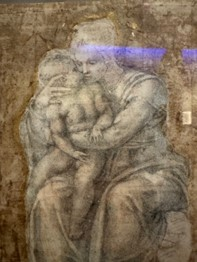Waiting, Hoping and Contemplating Christmas

Michelangelo drawing, Virgin and Child. Image A Abram
Anna Abram, Principal of The Margaret Beaufort Institute writes:
What do we mean when we say that we are waiting for Christ to be born? Surely, we are not waiting for the Baby Jesus to be born (this has already happened around 2024 years ago). I think we are waiting for a shift towards goodness in us and the world. We are waiting for God's grace to initiate this shift.
Every year, in our Christmas Newsletter, we focus on an image or set of images in order to interpret the notion of Christ's birth in the context of the world we inhabit now.
Five years ago we engaged with Pope Francis' Apostolic Letter 'Admirabile Signum' ('Enchanting Image'): On the Meaning and Importance of the Nativity Scene' in which we were invited to contemplate the nativity scene. We 'virtually' visited different representations of the Christmas Crib including 'The Millenial Nativity ' with Mary, drinking coffee from a disposable cup, and Joseph, taking a selfie (find the image here). It was fun and meaningful.
The past few years reminded us that Christmastime is often more a sad than a joyful time, for such reasons as a pandemic, the death of loved ones, a natural disaster or a war. We all know, as did the Holy Family, the pain of suffering. Our world and the world into which Jesus was born are not that different. Anguish, insecurity, brokenness, divisions, violence as well as moments of joy and experiences of beauty and love are known to us as they were known to them. And, in both worlds, Jesus' and ours, some moments define history. In our world, we find ourselves facing a new international order, wars in many regions, lives and societies altered by AI technologies and climate change. There are many problems to solve, and we are not always solving the right ones.
Waiting for Christ's birth is an opportunity to take a step back, to ponder on life's problems and prospects, to silence the noise, internally as well as externally. Waiting for Christ's birth gives us a chance to contemplate and see what emerges. In this contemplative space, we might want to engage with bigger questions that we rarely have time to ask: What am I called to be and do with whatever is left of my life? What are my priorities? What do I hope for in the Holy Year of 2025 (the Year of Hope)? The Catholic philosopher John Cottingham speaks of hope as a trusting and faithful reaching forward in the face of vulnerability. I recommend his paper 'Hope and the Virtues'.
The image that I would like to share with you as a visual guide for contemplation is Michelangelo's drawing 'Virgin and Child' which I photographed at the recent exhibition 'Michelangelo: the last decades' at the British Museum. It is estimated that Michelangelo was about 70 years old when he made it. What is special about this drawing and other works from this time is that he did them for their own sake (they were not commissioned). They seem to represent a change in him (internally and probably physically too; it must have been harder to hold the pencil though he continued to produce outstanding works until his eighties). Michelangelo seems to be in touch with a deeper mystery and responds to it in a more personal and intimate way. The mother is cradling her child, but not in a typical way. We see closeness and vulnerability. Perhaps the mother is feeling deep emotions such as grief or fear, or perhaps she is trying to solve a problem. What do you see in it?
May we allow ourselves to be challenged by this image and open the meditative space as Michelangelo did. May we find hope in vulnerability.
Hope-filled and Beautiful Christmas to each and everyone!
Anna Abram
Principal
The Margaret Beaufort Institute


















